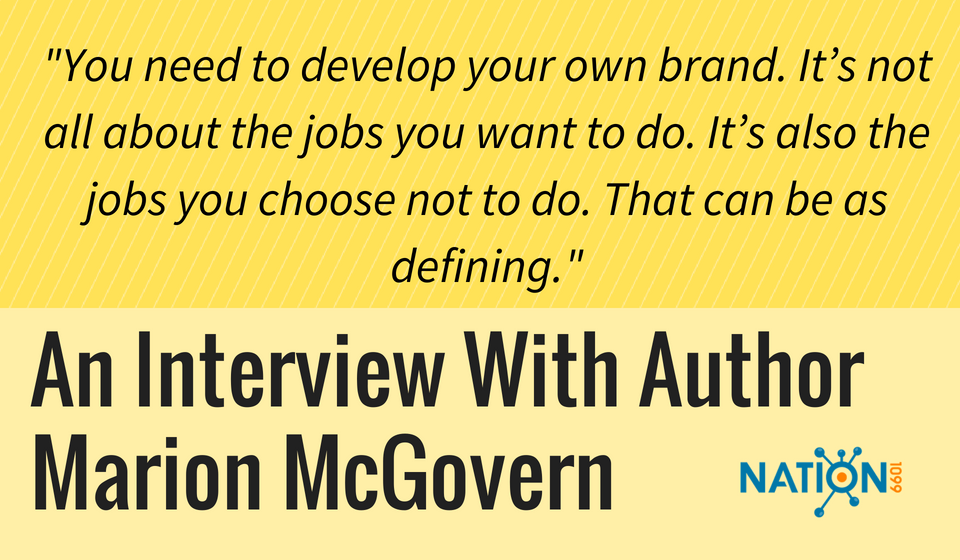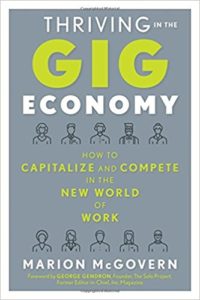Marion McGovern’s new book, Thriving In the Gig Economy: How to Capitalize and Compete In the New World of Work, examines how best-in-class business and creative professionals are choosing to work independently. After explaining the trends that drive the growth of the freelance workforce, she provides advice on building a brand, setting rates and developing your freelance business.
What I liked about Thriving In the Gig Economy is that it’s one of the few guidebooks for freelancers that includes strategy advice rather than just a grab bag of tactics disassociated from a plan for your business. She discusses some of those strategy tools in the interview below.
Marion’s own consulting career has focused on solving talent sourcing problems, so she has been part of the emerging gig economy for long time, as the founder and CEO of M Squared Consulting and as founder of Collabrus.
Her 2001 book, A New Brand of Expertise: How Independent Consultants, Free Agents, and Interim Managers are Transforming the World of Work, was one of the early descriptions of the growing trend of independent work.
What would you advise the freelancer who is experienced but not yet thriving in the gig economy?
You can’t just put a profile up and hope you get called. You have to do the extracurriculars. Some of these freelance sites have webinars or interest groups. You get on these phone calls that are sometimes valuable, sometimes less so. But you have to do those things. You can’t just think because you’re in there they’re going to find you.
When I was doing the book research I would actually allocate four hours on Monday to check all the online groups I’m in and to create some posts. You have to spend the time.
You have to budget time to work on the business. Sometimes freelance creatives just want to do the work they specialize in.
There’s working on the business to get business, and there’s working on the business to run the business — the financial part, the invoicing and, everyone’s favorite part, calling a delinquent client.
I believe you need to develop your own brand. You really do. What is your special sauce? What do you bringing to the table that someone else might not?
It’s not all about the jobs you want to do. It’s also the jobs you choose not to do. That can be as defining.
There are lots of ways to go building your own brand. One of the easiest ways is just to borrow from corporate strategy and do a SWOT. What are your strength, weaknesses, opportunities and threats?
That whole notion of weaknesses is weaknesses relative to whom? If you’re a copywriter, are you weak relative to their internal staff? Are you weak relative to a P.R. firm? What comparison are you making?
Why do you think freelancers have trouble committing to a niche?
They have economic volatility. At what point are you confident enough to look a gift horse in the mouth?
You can say, “There are the things that I’m passionate about and good at and that’s what I want to be doing when I’m in the flow. But there’s also this stuff that I know how to do because I’ve been trained to do it. Given that it’s going to give me a good paycheck for the next three months, I can do a fine job at that.”
How do you see freelancers deciding their pricing strategy?
There are a lot of different ways to price, and too many people just default to an hourly. If anything, people should default to a project rate.
There are lots of ways to go about that. Far too few people think about retainers. There’s a comfort knowing you can just go back to Robert to write the speech you just got signed up to give. Having that trusted resource at the ready. Lawyers do it all the time. Why can’t other people have retainers?
Freelance Rate Calculator: Know Your Expenses To Know Your Minimum
You mention the one percent rule in your book. Will you explain that?
Whatever the annual rate would be for an employed role, one percent of that is the day rate. And you can do the division to get to the hourly.
It’s good for explaining to your clients how you come up with your fees. “I just use the one percent rule. Let me explain to you how it works. Wouldn’t you agree that what you’d pay someone annually?”
But I also believe that it’s not just what you’re worth. It’s what the work is worth. If it’s valuable to them, you can command a premium.
Apart from their skills, what allows some freelancers to thrive in the gig economy while their peers are stuck with their work being priced as a commodity?
As one of my board members said to me back in the day, “If you’re not losing on price, you’re not pricing high enough.” Some people are reluctant to raise their rate. Once you set some rates it’s really hard to say you’re going to do something different.
You should consider, “How else would they do it?” Human capital is an array of instruments, just like finance is an array of instruments that a treasurer has.
The best comparison would be the people who are looking at McKinsey or the Bain, because there the price point is enormously higher than an independent consultant.
A Script To Help Raise Your Rate With Current Freelance Clients
How is the ecosystem of support services changing for the freelance workforce?
People are not waiting for the government to solve issues around the social safety net. They are realizing that market inefficiencies hold things back so they’re coming up with interesting options.
For example, there are new health insurance models for independent workers coming out that use initial coin offerings.
My personal hope is that someone will develop a mortgage product aimed at freelancers where you can increase your payments in a good period and not be penalized.
What’s the magic of a W-2 (for approving a mortgage)? You could lose your job tomorrow. If anything, a demonstrable 1099 income record is way more compelling. If these people are still doing this year after year, they’re good enough that can keep doing this.
For any recruiters or talent executives reading this, what trends should they be watching?
Companies need to figure out how to empower independents just as much as their employees. MBO Partners is figuring out the “client of choice” measure just like Glassdoor has figured out the “employer of choice.”
The other side of that is that you can’t have the independent workers seen as second-class citizens. Recruiters could have a tremendous impact on that change. When a client comes to them and says I really need to hire a person to do this job, they can pause and say, “What’s the work? There might be a better way to get this work done if we don’t just look at people who want to be an employee but figure out who would really be good for this.”
The average tenure at a technology company in Silicon Valley is 16 months for employees. Why are they spending so much time and money on full hires when they’re only lasting 16 months? They need to recognize that there is a mobility there. Whatever you call it, that’s a 16-month gig.
That’s a trend I’ve been tracking, too — how much role-based employees are acting like freelancers.
They’re looking out for their own careers. Freelancers Union and Upwork’s study showed that freelancers are upskilling way more than employees are. They’re realizing they have to.
Part of what’s happening is that employees are realizing they’re not getting the opportunities. “I’m not getting the exposure to new stuff I thought I was going to get, so I’m going to move over here.”

Robert McGuire
Publisher of Nation1099
Robert McGuire is the owner of McGuire Editorial, a content marketing services firm specializing in B2B and tech startups.











